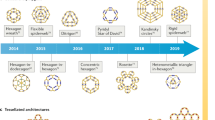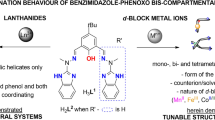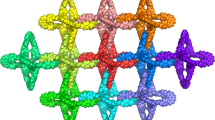Abstract
Borromean rings or links are topologically complex assemblies of three entangled rings where no two rings are interlinked in a chain-like catenane, yet the three rings cannot be separated. We report here a metallacycle complex whose crystalline network forms the first example of a new class of entanglement. The complex is formed from the self-assembly of CuBr2 with the cyclotriveratrylene-scaffold ligand (±)-tris(iso-nicotinoyl)cyclotriguaiacylene. Individual metallacycles are interwoven into a two-dimensional chainmail network where each metallacycle exhibits multiple Borromean-ring-like associations with its neighbours. This only occurs in the solid state, and also represents the first example of a crystalline infinite chainmail two-dimensional network. Crystals of the complex were twinned and have an unusual hollow tubular morphology that is likely to result from a localized dissolution-recrystallization process.
This is a preview of subscription content, access via your institution
Access options
Subscribe to this journal
Receive 12 print issues and online access
$259.00 per year
only $21.58 per issue
Buy this article
- Purchase on Springer Link
- Instant access to full article PDF
Prices may be subject to local taxes which are calculated during checkout





Similar content being viewed by others
References
Sauvage, J-P. & Dietrich-Buchecker, C. O. (eds) Molecular Catenanes, Rotaxanes and Knots. A Journey Through the World of Molecular Topology (Wiley-VCH, 1999).
Forgan, R. S., Sauvage, J-P. & Stoddart, J. F. Chemical topology: complex molecular knots, links, and entanglements. Chem. Rev. 111, 5434–5464 (2011).
Ayme, J-F., Beves, J. E., Campbell, C. J. & Leigh, D. A. Template synthesis of molecular knots. Chem. Soc. Rev. 42, 1700–1712 (2013).
Yang, W., Li, Y., Liu, H., Chi, L. & Li, Y. Design and assembly of rotaxane-based molecular switches and machines. Small 8, 504–516 (2012).
Credi, A., Ventur, M. & Balzani, V. Light on molecular machines. ChemPhysChem. 11, 3398–3403 (2010).
Ali, C. et al. High hopes: can molecular electronics realize its potential? Chem. Soc. Rev. 41, 4827–4859 (2012).
Neal, E. A. & Goldup, S. M. Chemical consequences of mechanical bonding in catenanes and rotaxanes: isomerism, modification, catalysis and molecular machines for synthesis. Chem. Commun. 50, 5128–5142 (2014).
Zhang, G., Presly, O., White, F., Oppel, I. M. & Mastalerz, M. A shape-persistent quadruply interlocked giant cage catenane with two distinct pores in the solid state. Angew. Chem. Int. Ed. 53, 5126–5130 (2014).
Hasell, T. et al. Triply interlocked covalent organic cages. Nature Chem. 2, 750–755 (2010).
Westcott, A., Fisher, J., Harding, L. P., Rizkallah, P. & Hardie, M. J. Self-assembly of a 3-D triply interlocked chiral [2]catenane. J. Am. Chem. Soc. 130, 2950–2951 (2008).
Henkelis, J. J., Ronson, T. K., Harding, L. P. & Hardie, M. J. M3L2 metallo-cryptophanes: [2]catenane and simple cages. Chem. Commun. 47, 6560–6562 (2011).
Wang, L., Vysotsky, M. O., Bogdan, A., Bolte, M. & Bohmer, V. Multiple catenanes derived from calix[4]arenes. Science 304, 1312–1314 (2004).
Leigh, D. A., Pritchard, R. G. & Stephens, A. J. A star of David catenane. Nature Chem. 6, 978–982 (2014).
Niergarten, J-F., Dietrich-Buchecker, C. O. & Sauvage, J-P. Synthesis of a doubly interlocked [2]-catenane. J. Am. Chem. Soc. 116, 375–376 (1994).
Mao, C., Sun, W. & Seeman, N. C. Assembly of Borromean rings from DNA. Nature 386, 137–138 (1997).
Peters, A. J., Chichak, K. S., Cantrill, S. J. & Stoddart, J. F. Nanoscale Borromean links for real. Chem. Commun. 3394–3396 (2005).
Chichak, K. S. et al. Molecular Borromean rings. Science 304, 1308–1312 (2004).
Huang, S-L., Lin, Y-J., Li, Z-H. & Jin, G-X. Self-assembly of molecular Borromean rings from bimetallic coordination rectangles. Angew. Chem. Int. Ed. 53, 11218–11222 (2014).
Huang, S-L., Lin, Y-J., Hor, T. S. A. & Jin, G-X. Cp*Rh-based heterometallic metallarectangles: size-dependent Borromean link structures and catalytic acyl transfer. J. Am. Chem. Soc. 135, 8125–8128 (2013).
Li, F., Clegg, J. K., Lindoy, L. F., Macquart, R. B. & Meehan, G. V. Metallosupramolecular self-assembly of a universal 3-ravel. Nature Commun. 2, 205 (2011).
Carlucci, L., Ciani, G., Proserpio, D. M., Mitina, T. G. & Blatov, V. A. Entangled two-dimensional coordination networks: a general survey. Chem. Rev. 114, 7557–7580 (2014).
Batten, S. R. in Supramolecular Chemistry: From Molecules to Nanomaterials Vol. 6 (eds Gale, P. A. & Steed, J. W.) 3107–3120 (Wiley, 2012).
Carlucci, L., Ciani, G. & Proserpio, D. M. Polycatenantion, polythreading and polyknotting in coordination network chemistry. Coord. Chem. Rev. 246, 247–289 (2003).
Jin, C-M., Lu, H., Wu, L-Y. & Huang, J. A new infinite inorganic infinite [n]catenane from silver and bis(2-methylimidazoyl)methane ligand. Chem. Commun. 5039–5041 (2006).
Loots, L. & Barbour, L. J. An infinite catenane self-assembled by π···π interactions. Chem. Commun. 49, 671–673 (2012).
Sagué, J. L. & Fromm, K. M. The first two-dimensional polycatenane: a new type of robust network obtained by Ag-connected one-dimensional polycatenes. Cryst. Growth Des. 6, 1566–1568 (2006).
Kuang, X. et al. Assembly of a metal–organic framework by sextuple intercatenation of discrete adamantane-like cages. Nature Chem. 2, 461–465 (2010).
Heine, J., Schmedt auf der Günne, J. & Dehnen, S. Formation of a strandlike polycatenane of icosahedral cages for reversible one-dimensional encapsulation of guests. J. Am. Chem. Soc. 133, 10018–10021 (2011).
Dolomanov, O. V., Blake, A. J., Champness, N. R., Schröder, M. & Wilson, C. A novel synthetic strategy for hexanuclear supramolecular architectures. Chem. Commun. 682–683 (2003).
Schmittel, M. et al. Cap for copper(I) ions! Metallosupramolecular solid and solution state structures on the basis of the dynamic tetrahedral [Cu(phenAr2)(py)2]+ motif. Inorg. Chem. 48, 8192–8200 (2009).
Loren, J. C., Yoshizawa, M., Haldimann, R. F., Linden, A. & Siegel, J. S. Synthetic approaches to a molecular Borromean link: two-ring threading with polypyridine templates. Angew. Chem. Int. Ed. 42, 5702–5705 (2003).
Carlucci, L., Ciani, G. & Proserpio, D. M. Borromean links and other non-conventional links in ‘polycatenated’ coordination polymers: re-examination of some puzzling networks. CrystEngComm 5, 269–279 (2003).
Pan, M. & Su, C-Y. Coordination assembly of Borromean structures. CrystEngComm 16, 7847–7859 (2014).
Hardie, M. J. Recent advances in the chemistry of cyclotriveratrylene. Chem. Soc. Rev. 39, 516–527 (2010).
Ronson, T. K. et al. Stellated polyhedral assembly of a topologically complicated Pd4L4 ‘Solomon cube’. Nature Chem. 1, 212–216 (2009).
Hardie, M. J. & Sumby, C. J. An interwoven 2-D coordination network prepared from the molecular host tris(isonicotinyl)cyclotriguaiacylene and silver(I) cobalt(III) bis(dicarbollide). Inorg. Chem. 43, 6872–6874 (2004).
Ronson, T. K., Fisher, J., Harding, L. P. & Hardie, M. J. Star-burst prisms with cyclotriveratrylene-type ligands: a [Pd6L8]12+ stella octangula. Angew. Chem. Int. Ed. 46, 9086–9088 (2007).
Eddleston, M. D. & Jones, W. Formation of tubular crystals of pharmaceutical compounds. Cryst. Growth Des. 10, 365–370 (2010).
Niu, Z. & Gibson, H. W. Polycatenanes. Chem. Rev. 109, 6024–6046 (2009).
Fang, L. et al. Mechanically bonded macromolecules. Chem. Soc. Rev. 39, 17–29 (2010).
Duda, R. L. Protein chainmail: catenated protein in viral capsids. Cell 94, 55–60 (1998).
Hao, C. & March, R. E. Electrospray ionization tandem mass spectrometric study of salt cluster ions: Part 2 – Salts of polyatomic acid groups and of multivalent metals. J. Mass. Spectrom. 36, 509–521 (2001).
Zhao, Y. S. et al. Optical waveguide based on crystalline organic microtubes and microrods. Angew. Chem. Int. Ed. 47, 7301–7305 (2008).
Zhang, X-L. et al. Discrete chiral single-crystal microtubes assembled with honeycomb coordination networks showing structural diversity and Borromean topology in one single crystal. Chem. Mater. 19, 4630–4632 (2007).
Ma, Y., Börner, H. G., Hartmann, J. & Cölfen, H. Synthesis of DL-alanine hollow tubes and core–shell mesostructures. Chem. Eur. J. 12, 7882–7888 (2006).
Sander, J. R. G., Bučar, D-K., Baltrusaitis, J. & MacGillivray, L. R. Organic nanocrystals of the resorcinarene hexamer via sonochemistry: evidence of reversed crystal growth involving hollow morphologies. J. Am. Chem. Soc. 134, 6900–6902 (2012).
Ulrich, J., Schuster, A. & Stelzer, T. Crystalline coats or hollow crystals as tools for product design in pharmaceutical industry. J. Cryst. Growth 362, 235–237 (2013).
Chen, Y., Zhu, B., Zhang, F., Han, Y. & Bo, Z. Hierarchical supramolecular self-assembly of nanotubes and layered sheets. Angew. Chem. Int. Ed. 47, 6015–6018 (2008).
Henkelis, J. J. et al. Metallo-cryptophanes decorated with bis-N-heterocyclic carbene ligands: self-assembly and guest uptake into a non-porous crystalline lattice. J. Am. Chem. Soc. 136, 14393–14396 (2014).
Sheldrick, G. M. A short history of SHELX. Acta Crystallogr. A64, 112–122 (2008).
Acknowledgements
The authors acknowledge the Engineering and Physical Sciences Research Council for funding this research, T. Marinko-Covell for microanalysis, A. Kazlauciunas for EDX and thermal gravimetric analysis measurements and S. Warriner for assistance with mass spectrometry. The authors thank S. Hyde for useful discussions regarding topology. The authors acknowledge Diamond Light Source for time on beamline I19 under proposal MT8911.
Author information
Authors and Affiliations
Contributions
F.L.T-G. and M.J.H. conceived and designed experiments. F.L.T-G. performed synthetic, crystallographic and other characterization experiments and A.N.K. performed SEM experiments. All authors contributed to analysis of the data. M.J.H. wrote the paper with discussions and contributions from F.L.T-G. and some diagrams prepared by A.N.K.
Corresponding author
Ethics declarations
Competing interests
The authors declare no competing financial interests.
Supplementary information
Supplementary information
Supplementary information (PDF 3309 kb)
Supplementary information
Crystallographic data for compound 1. (CIF 54 kb)
Rights and permissions
About this article
Cite this article
Thorp-Greenwood, F., Kulak, A. & Hardie, M. An infinite chainmail of M6L6 metallacycles featuring multiple Borromean links. Nature Chem 7, 526–531 (2015). https://doi.org/10.1038/nchem.2259
Received:
Accepted:
Published:
Issue Date:
DOI: https://doi.org/10.1038/nchem.2259
This article is cited by
-
Catenated covalent organic frameworks constructed from polyhedra
Nature Synthesis (2023)
-
A new equilibrium for supramolecular chemists
Nature Chemistry (2021)
-
Stereoselective synthesis of a composite knot with nine crossings
Nature Chemistry (2018)
-
Synthesizing topological structures containing RNA
Nature Communications (2017)
-
Entanglement, space-time and the Mayer-Vietoris theorem
Journal of High Energy Physics (2017)



